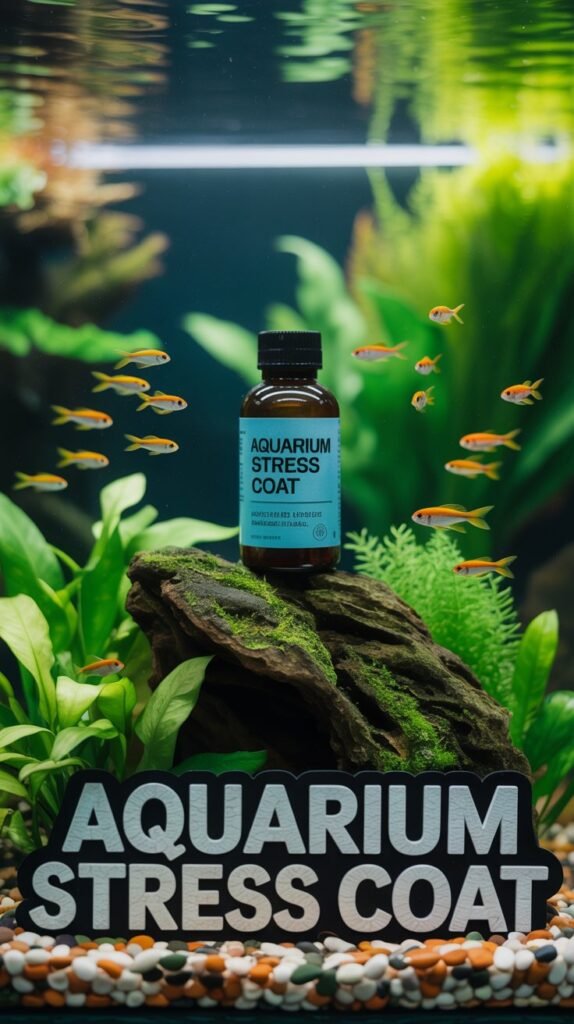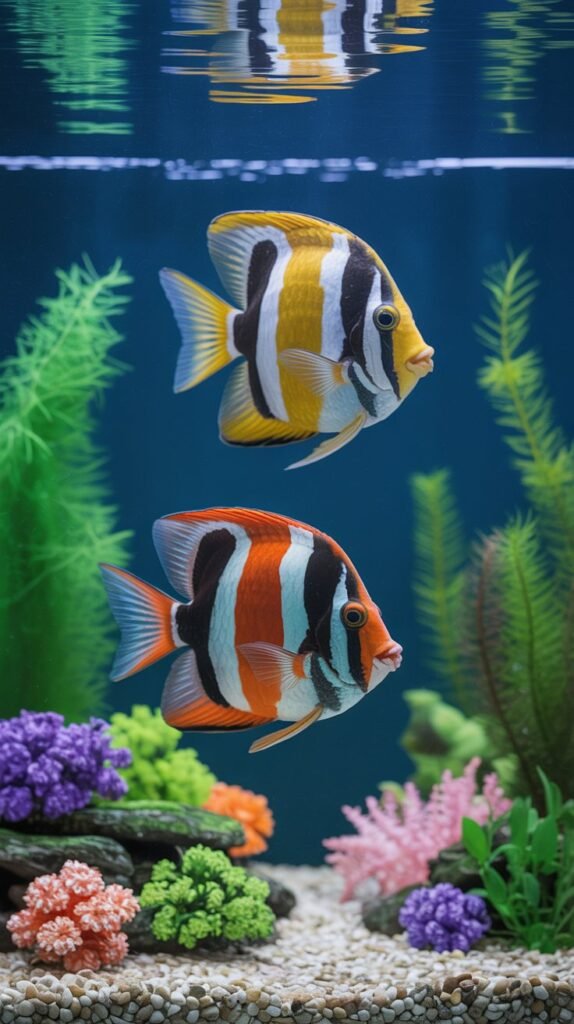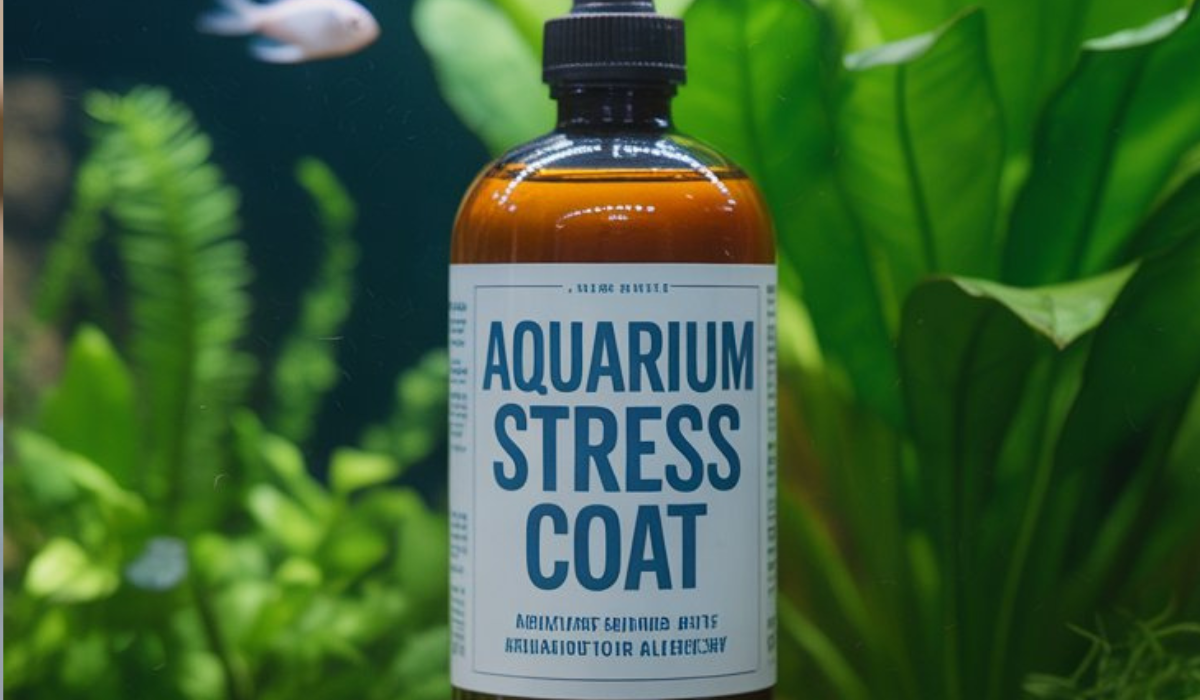Fish are more sensitive than they look. From water changes and transportation to illness and injury, aquarium fish experience stress that can weaken their immune systems and make them more prone to disease. Thankfully, one simple product can make a huge difference — the aquarium stress coat.
This complete guide will explain what an aquarium stress coat is, how it works, when to use it, and why it’s essential for every aquarium owner. Whether you’re a beginner or an experienced aquarist, understanding the role of stress coat can help you maintain healthier, happier fish.
What Is an Aquarium Stress Coat?
An aquarium stress coat is a special water conditioner designed to reduce fish stress, replace the protective slime coat, and neutralize harmful chemicals like chlorine and chloramine in tap water. It’s used whenever fish are exposed to stressful situations such as handling, transportation, or water changes.
The protective slime coat on a fish’s body is their first line of defense against infections and parasites. Stress, rough handling, or poor water conditions can damage this barrier — and that’s where the stress coat comes in. It replaces and strengthens the natural coating, acting as a healing shield.
Most popular products, such as API Stress Coat or Seachem StressGuard, also contain Aloe Vera extract, known for its soothing and healing properties.
Why Fish Need a Stress Coat

Fish live in a delicate balance with their environment. Even minor disruptions can trigger stress responses. Prolonged or frequent stress leads to weakened immunity, making fish vulnerable to diseases.
An aquarium stress coat provides multiple benefits, including:
1. Protects the Slime Coat
Fish naturally secrete a thin mucus layer that acts as protection from bacteria, fungi, and parasites. Stress coat products help restore this layer quickly after it’s been damaged.
2. Detoxifies Tap Water
Tap water often contains chlorine, chloramine, and heavy metals that are toxic to fish. Stress coat formulas neutralize these substances, making the water safe instantly.
3. Reduces Fish Stress
When added during water changes, transportation, or new tank setups, stress coat ingredients calm fish, reducing shock and erratic behavior.
4. Heals Wounds and Fin Damage
Many stress coats contain Aloe Vera or vitamin E, which promote healing of minor wounds, fin tears, or scale damage caused by aggression or handling.
5. Improves Water Quality
By reducing fish stress and damage, there’s less production of excess slime and waste, keeping the water cleaner and clearer.
6. Boosts Immunity
Consistent use helps fish resist infections and recover faster from illness or transport.
How Does an Aquarium Stress Coat Work?
The science behind stress coat products lies in two main functions — chemical detoxification and biological protection.
1. Chemical Detoxification
Most aquarium stress coats contain compounds like sodium thiosulfate, which neutralize chlorine and break the bond between chlorine and ammonia in chloramine-treated tap water. This ensures safe water instantly, without the need for long aging or aeration.
2. Biological Protection
The Aloe Vera extract or synthetic polymers in stress coat form a protective slime layer on fish skin. This layer:
- Prevents entry of pathogens
- Reduces osmotic stress
- Helps healing of damaged tissues
- Improves coloration and vitality
Together, these effects help fish recover faster, breathe easier, and stay healthy in fluctuating water conditions.
When to Use Aquarium Stress Coat

Knowing when to use stress coat can make all the difference in maintaining a stable aquarium. Here are the best times to use it✅ 1. During Water Changes
Every time you perform a water change, new tap water introduces chlorine, chloramine, or metals that can harm fish. Adding stress coat helps neutralize these instantly and reduces stress caused by environmental changes.
Dosage: Add the recommended amount directly to the new water before adding it to the tank.
✅ 2. When Introducing New Fish
New fish experience immense stress from transportation and acclimation. Using stress coat during introduction helps protect their slime coat and aids adaptation.
Tip: Use it both in the main tank and in quarantine tanks for maximum protection.
✅ 3. After Transport or Handling
Whenever you catch, net, or move fish, their protective layer can be scraped off. A stress coat helps heal these microabrasions and reduce infection risk.
✅ 4. During Illness or Injury
Fish suffering from fin rot, bacterial infections, or physical injuries benefit greatly from stress coat because of its healing and soothing effects.
✅ 5. After Medication Treatments
Many medications can irritate or dry out a fish’s skin. Stress coat helps restore their natural defenses after treatment.
✅ 6. During Breeding or Spawning
Breeding fish undergo hormonal and physical stress. Using stress coat ensures cleaner, safer water and helps fry and parents recover faster.
Ingredients in Aquarium Stress Coat
Let’s break down the common ingredients found in most aquarium stress coat formulations and their specific roles.
| Ingredient | Function |
|---|---|
| Aloe Vera Extract | Promotes healing, reduces inflammation, rebuilds slime coat |
| Sodium Thiosulfate | Detoxifies chlorine and chloramine |
| Chelating Agents | Bind and remove heavy metals |
| Polyvinylpyrrolidone (PVP) | Forms artificial protective slime coat |
| Electrolytes & Trace Elements | Support osmoregulation and fish health |
| Dechlorinators | Make tap water safe instantly |
These ingredients combine to create a multi-functional formula that not only detoxifies but also heals and protects.
How to Use Aquarium Stress Coat
Using stress coat correctly is crucial to get maximum benefits. Here’s a step-by-step guide:
Step 1: Read the Label
Different brands have slightly different dosages. Always check the manufacturer’s instructions first.
Step 2: Measure the Dosage
A general guideline is:
- 5 mL (1 teaspoon) per 10 gallons (38 liters) of water
- Double the dose during fish transportation, treatment, or after water changes
Step 3: Add to New Water
Add the correct dose of stress coat to tap water before adding it to your aquarium. This ensures harmful substances are neutralized instantly.
Step 4: Use During Emergencies
If fish show signs of distress (e.g., rapid breathing, color loss), you can add stress coat directly to the tank to calm them.
Step 5: Use Regularly for Maintenance
Regular use during water changes maintains optimal fish health and minimizes stress buildup.
Signs That Your Fish Need Stress Coat
It’s not always obvious when your fish are stressed. Watch for these signs to know when to use aquarium stress coat:
| Symptom | Possible Cause |
|---|---|
| Rapid or labored breathing | Chlorine exposure or poor water quality |
| Clamped fins | Water parameter changes |
| Loss of color | Stress or shock |
| Erratic swimming | Handling or transport stress |
| Hiding or lethargy | Overcrowding or sudden light changes |
| Scratching or flashing | Parasite irritation |
| Fin damage | Aggressive tankmates or handling injury |
Adding stress coat can help fish recover faster and prevent infections before they start.
Aquarium Stress Coat vs Regular Water Conditioner
You might wonder: Is stress coat just a fancy water conditioner? The answer is — not exactly.
| Feature | Regular Water Conditioner | Aquarium Stress Coat |
|---|---|---|
| Removes chlorine/chloramine | ✅ Yes | ✅ Yes |
| Detoxifies heavy metals | ✅ Yes | ✅ Yes |
| Replaces fish slime coat | ❌ No | ✅ Yes |
| Contains healing ingredients (Aloe Vera) | ❌ No | ✅ Yes |
| Reduces stress | ❌ Minimal | ✅ Strong effect |
| Recommended for injured or new fish | ❌ Not ideal | ✅ Excellent |
A stress coat is like an upgraded water conditioner — ideal when fish are injured, sick, or stressed.
Popular Aquarium Stress Coat Brands
Several trusted brands offer high-quality stress coat solutions. Here are the most popular ones among aquarists:
1. API Stress Coat+
- Contains Aloe Vera and advanced slime coat protection.
- Detoxifies chlorine, chloramine, and heavy metals.
- Instantly calms and heals fish.
- Ideal for freshwater and saltwater aquariums.
2. Seachem StressGuard
- Protein-active formula that binds to fish wounds for faster healing.
- Excellent for injury recovery and after medication.
- Works well with other Seachem products like Prime.
3. Tetra AquaSafe Plus
- Neutralizes chlorine and heavy metals.
- Contains slime protectant and vitamin B for stress relief.
- Great for community tanks.
4. API Pond Stress Coat
- Formulated for ponds and large outdoor systems.
- Helps koi and goldfish during seasonal transitions or handling.
Each brand varies slightly in formula strength and concentration, but all serve the same purpose: reducing fish stress and protecting slime coats.
Combining Stress Coat with Other Treatments
Aquarium stress coats are generally safe to use with most other aquarium products. However, it’s important to understand compatibility.
Safe Combinations:
- Dechlorinators (usually redundant but safe)
- Beneficial bacteria supplements
- Most antibiotics and antifungal treatments
- Aquarium salt (in low doses)
Use Caution:
- Copper-based medications — may interact slightly with aloe or polymers
- High doses — can make protein skimmers overflow in marine tanks
Always check product labels before mixing, especially in sensitive or reef environments.
Common Mistakes to Avoid
Even though stress coat is generally safe, some mistakes can reduce its effectiveness or harm your aquarium balance.
| Mistake | Why It’s a Problem |
|---|---|
| Overdosing stress coat | May lower oxygen levels temporarily |
| Mixing brands | Chemical reactions or residue buildup |
| Ignoring water changes | Stress coat isn’t a substitute for clean water |
| Using expired product | Reduced effectiveness |
| Adding before dechlorination | Tap chlorine can still affect fish before neutralization |
Always use fresh, correctly dosed stress coat during water changes for best results.
The Role of Stress Coat in Fish Disease Prevention
Regular use of aquarium stress coat creates a protective barrier against many common freshwater fish diseases.
Diseases It Helps Prevent:
- Fin rot
- Ich (White Spot Disease)
- Columnaris (Cotton Mouth)
- Bacterial ulcers
- Fungal infections
By strengthening the slime coat and reducing stress-induced immune suppression, it lowers the likelihood of these conditions appearing.
Can Stress Coat Be Used in Saltwater Aquariums?
Yes — but with limitations. Many marine aquarists use Seachem StressGuard or API Stress Coat Marine, both specifically formulated for saltwater tanks. Regular freshwater formulas can interfere with protein skimmers and foam fractionators.
For marine tanks:
- Use marine-specific versions.
- Reduce dosage slightly (½ the freshwater recommendation).
- Avoid excessive use that may affect coral or invertebrates.
Natural Alternatives to Stress Coat
If you prefer natural solutions, there are a few alternatives to commercial stress coat products:
Aloe Vera Gel
Natural Aloe Vera contains polysaccharides that mimic the slime coat. However, use only pure, additive-free gel in very small amounts (1–2 drops per gallon).
Indian Almond Leaves (Catappa Leaves)
Release natural tannins that reduce stress, heal wounds, and create a natural protective environment for soft-water species.
Regular Water Changes
Clean water is the best stress prevention method. Consistent maintenance reduces toxins and promotes natural slime coat regeneration.
How Often Should You Use Stress Coat?
The frequency depends on your tank maintenance routine and fish condition.
| Situation | Frequency |
|---|---|
| Regular water changes | Every time new water is added |
| New fish introduction | Before and after adding fish |
| Fish illness or injury | Daily for 3–5 days |
| Post-medication recovery | Once daily for 5–7 days |
| Regular maintenance | Once every 1–2 weeks |
Using it consistently helps fish stay calm and maintain a strong slime barrier.
Conclusion
An aquarium stress coat is one of the simplest yet most powerful tools for keeping your fish healthy and stress-free. It not only neutralizes harmful tap water chemicals but also repairs and strengthens the fish’s natural protective barrier.
Whether you’re performing a water change, introducing new fish, or treating an injury, stress coat helps minimize stress, prevent disease, and speed up recovery.
In short:
👉 Safe for all freshwater fish
👉 Reduces stress and promotes healing
👉 Replaces the slime coat and detoxifies water
It’s an absolute must-have for any aquarium hobbyist who wants their fish to thrive in a safe, stress-free environment.
FAQs About Aquarium Stress Coat
Q1. What does aquarium stress coat do?
It detoxifies harmful chemicals in tap water, replaces the slime coat on fish, and reduces stress caused by handling, transportation, or illness.
Q2. Can I use stress coat every time I change the water?
Yes, it’s recommended to use stress coat during every water change to neutralize chlorine and protect fish.
Q3. Is stress coat safe for all fish?
Yes, most freshwater fish tolerate it well. However, reduce dosage for scaleless or sensitive species like loaches and catfish.
Q4. Does stress coat help with fish injuries?
Yes, the Aloe Vera and polymers in stress coat help heal small wounds, torn fins, and abrasions.
Q5. Can stress coat replace water conditioners?
Yes — most stress coats act as water conditioners with added healing benefits.
Q6. Can I use stress coat in a planted tank?
Yes, it’s safe for live plants and will not harm them.
Q7. Can I overdose aquarium stress coat?
Slight overdoses are generally safe, but repeated overuse can lower oxygen temporarily or affect skimmers in marine tanks.
Q8. Is stress coat safe for shrimp or snails?
Yes, in normal doses it’s safe for most invertebrates. Avoid excessive dosing in nano tanks.
Q9. Can I mix stress coat with salt treatments or medications?
Yes, it’s compatible with most common treatments, but always check the label or consult an aquarist first.
Q10. How long does stress coat last in the aquarium?
Its effects last for several days, but it’s best to reapply during water changes or after stressful events.

